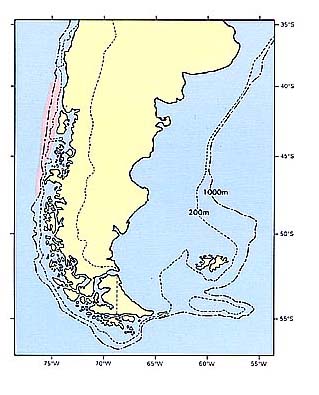チゴダラ科
- HOME
- デジタル図鑑
- パタゴニア海域の重要水族
- 硬骨魚綱 タラ目
- チゴダラ科
チゴダラ科(Moridae)

25 Salilota sp.
特 徴:
背鰭4〜6軟条,62〜68軟条,臀鰭59〜62軟条,胸鰭22〜23軟条,腹鰭5軟条,鰓条骨数7,鰓耙数7〜8+0+18〜22=25〜29,側線鱗数25〜26。頭長は体長の26.8〜27.0%,眼径は4.8〜5.3%,吻長は7.6〜8.6%,両眼間隔は7.7〜8.3%,上顎長は13.4〜13.9%,尾柄高は2.2〜2.9%,胸鰭長は14.2〜17.6%,腹鰭長は13.8〜16.9%,第1背鰭高は6.4〜8.7%,第2背鰭高は9.0〜12.5%,臀鰭高は7.7〜9.1%。体はやや細長く,側扁する。頭は大きくわずかに縦扁し,体長は頭長の約3.7倍。吻は短くて円純で,吻長は両眼間隔とほぼ等しい。眼はむしろ大きい。両眼間隔域は平坦。下顎下面先端に小さな髭がある。口は大きくて斜位。上顎後端は瞳の後縁下に達する。肉質皮弁が両顎にわずかに発達する。両鼻孔は相接近し,前鼻孔は切れ込みのある皮弁を備えるが,後鼻孔には皮弁がない。両顎に2列の犬歯が発達し,外列のほうが大きい。数箇の小歯が鋤骨上にある。擬鰓はない。鰓耙は中庸。小円鱗が唇,峡部,および背鰭と臀鰭の基底部を除く頭部と体側に分布する。胸鰭は丸く,起部は背鰭起部下に位置する。腹鰭は鰓蓋後縁下に位置し,左右のものは相離れる。肛門の周囲に発光器が存在する。肛門は第1背鰭の第2または第3軟条下に位置する。背鰭と臀鰭は前方で高く後方に行くに従って徐々に低くなり,両者の基底とも長い。尾鰭は小さい。側線は前方で湾曲し,後方では真直ぐに走り,側線孔は明確である。体は褐色で各鰭は黒色。
分 布:
チリ パタゴニアの深海中層。
備 考:
本種の同定には今のところ成功していない。なお分類学的研究を継続中である。
(中村 泉)
Material examined:
3 from Chile (135.8-165.2 mm SL), FAKU CP 344, 348, 745.
Description:
D 4-6, 62-68; A 59-62; P1 22-23; P2 5; GR 7-8+0+18-22=25-29; BR 7; LLS 25-26.
HL 26.8-27.0 % of SL; ED 4.8-5.3; SN 7.6-8.6; IO 7.7-8.3; UJ 13.4-13.9; CP 2.2-2.9; P1L 14.2-17.6; P2L 13.8-16.9; D1H 6.4-8.7; D2H 9.0-12.5; AH 7.7-9.1.
Body elongate and compressed with slightly depressed head. Head large, about 3.7 times in SL. Snout short and round, its length equal to interorbital width. Eye rather large. Interorbital region flat. A small barbel on chin. Two nostrils, anterior one with fringed flap. Mouth large, oblique; end of maxilla extending to posterior margin of pupil. Freshy lips slightly developed on both jaws. Biserial canine teeth on both jaws; outer row enlarged. Several small teeth on vomer. No teeth on palatine. Pseudobranchiae absent. Gill-rakers moderate in size. Small cycloid scales present all over body except on lips, ithsmus, and dorsal and anal fin bases. Pectoral fin round, its base situated under first dorsal fin origin. Pelvic fins at about level of posterior margin of preopercle in position and well separated from each other. Luminescent organ present around anus. Anus situated below 2nd or 3rd ray of 2nd dorsal fin. Single lateral line consists of dotted pores, running from upper insertion of opercle to about end of second dorsal fin, curving downward posterior to pectoral fin, thereafter straight from anterior one-third of anal fin base. Body brown and all fins more or less black.
Distribution:
Chilean Patagonia, bathypelagic.
Remarks:
Possibly new to science. Further study is proceeding.
(Izumi NAKAMURA)

Distribution of Salilota sp. in Patagonia.